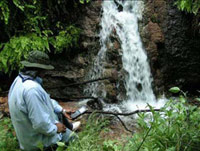Water: Wetlands Program Development Grants
Wetland Program Development Grants (WPDGs) Case Studies

The Environmental Protection Agency's (EPA's) wetland program has a primary goal of increasing the quantity and quality of wetlands in the U.S. through a variety of regulatory and non-regulatory approaches. State and Tribal wetland protection programs play a crucial role in achieving this goal. EPA has sought to build the capacity of state and tribal government to develop and implement effective, comprehensive programs for wetland protection and management. The Wetland Program Development Grants (WPDGs) are the primary mechanism through which EPA supports state and tribal efforts to build programs that protect valuable wetland resources.
The WPDG program was initiated in FY90 to provide states and tribes an opportunity to carry out projects to develop and refine comprehensive wetland programs. In order to better guide state and tribal efforts in establishing comprehensive wetland programs, EPA identified six core elements of a comprehensive wetland program in 1999. These elements are:
- Regulation;
- Monitoring and Assessment;
- Restoration;
- Water Quality Standards;
- Public-Private Partnerships; and
- Coordination.
They provide a framework within which states and tribes can assess the completeness of their wetland programs. Grants are awarded competitively by each EPA region and headquarters. Each year, the grant program identifies priority areas within these main elements to encourage proposals to focus on specific program needs. Sample priorities include refining the protection of vulnerable waters, improving the effectiveness of compensatory mitigation and developing monitoring and assessment programs.
Many states and tribes have utilized WPDG funds to develop aspects of the six core elements in their wetland program. Of course, building a comprehensive wetland program is progressive and many WPDG recipients continue to work hard at incorporating the remaining elements of a comprehensive program. This document highlights successful use of WPDGs in building one or more elements of a wetlands protection program and serves as an example to others who are striving to develop comprehensive programs.
The foundation of any wetland program is an understanding of the location, extent and condition of wetland resources. Thus, wetland condition and wetland water quality issues have been at the forefront of Clean Water Act activities for the past several years. Many states, tribes and federal and state work groups have been exploring and developing assessment methodologies to meet that priority goal. These efforts have emphasized the need for a scientifically sound assessment of the chemical, physical and biological health of wetlands and the need for standardized approaches to facilitate the development of trend analyses and geographically comparable data. Several WPDG recipients have used the grant program to develop strategies, create and modify assessment tools and begin forums for sharing information in order to better characterize and manage their wetlands.
Several case studies mention EPA's Environmental Outcome Wetland Demonstration Pilot (WDP) in the discussion of their current work and future plans. This one-time program gave more advanced state and tribal wetland programs an opportunity to utilize grant funds to implement various program components that had already been sufficiently developed. WDP was initiated in 2005 through a competitive grant process in which applicants were instructed to demonstrate how their proposed activities would link to environmental results at the end of the 3-year grant period. Many former WPDG recipients were ready to take this crucial step into program implementation and took advantage of this unique prospect.
EPA selected current and former grant recipients from across the country that utilized the grant program to support wetland program development on a broad scale. The result is a case studies document that highlights numerous approaches to wetland protection from a diverse group of grantees. The final document tells 25 individual stories from 11 state agencies; five tribes; three multi-agency work groups; two counties; one state park; one university; and two non-government organizations.
Case Studies Table of Contents